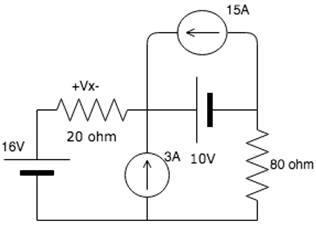Electrical Engineering (EE) Exam > Electrical Engineering (EE) Tests > Network Theory (Electric Circuits) > Test: Superposition Theorem - Electrical Engineering (EE) MCQ
Test: Superposition Theorem - Electrical Engineering (EE) MCQ
Test Description
10 Questions MCQ Test Network Theory (Electric Circuits) - Test: Superposition Theorem
Test: Superposition Theorem for Electrical Engineering (EE) 2025 is part of Network Theory (Electric Circuits) preparation. The Test: Superposition Theorem questions and answers have been
prepared according to the Electrical Engineering (EE) exam syllabus.The Test: Superposition Theorem MCQs are made for Electrical Engineering (EE) 2025 Exam. Find important
definitions, questions, notes, meanings, examples, exercises, MCQs and online tests for Test: Superposition Theorem below.
Solutions of Test: Superposition Theorem questions in English are available as part of our Network Theory (Electric Circuits) for Electrical Engineering (EE) & Test: Superposition Theorem solutions in
Hindi for Network Theory (Electric Circuits) course. Download more important topics, notes, lectures and mock
test series for Electrical Engineering (EE) Exam by signing up for free. Attempt Test: Superposition Theorem | 10 questions in 10 minutes | Mock test for Electrical Engineering (EE) preparation | Free important questions MCQ to study Network Theory (Electric Circuits) for Electrical Engineering (EE) Exam | Download free PDF with solutions
Test: Superposition Theorem - Question 1
In superposition theorem, when we consider the effect of one current source, all the other voltage sources are____________
Detailed Solution for Test: Superposition Theorem - Question 1
Detailed Solution for Test: Superposition Theorem - Question 2
Detailed Solution for Test: Superposition Theorem - Question 3
Detailed Solution for Test: Superposition Theorem - Question 4
Detailed Solution for Test: Superposition Theorem - Question 5
Detailed Solution for Test: Superposition Theorem - Question 6
Detailed Solution for Test: Superposition Theorem - Question 7
Detailed Solution for Test: Superposition Theorem - Question 8
Detailed Solution for Test: Superposition Theorem - Question 9
Detailed Solution for Test: Superposition Theorem - Question 10
|
68 videos|88 docs|62 tests
|
Information about Test: Superposition Theorem Page
In this test you can find the Exam questions for Test: Superposition Theorem solved & explained in the simplest way possible.
Besides giving Questions and answers for Test: Superposition Theorem, EduRev gives you an ample number of Online tests for practice























